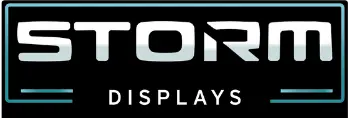You’ve booked your space at the year’s most important trade show, and your marketing goals are set. Now comes the real challenge: how do you transform that empty patch of concrete into a branded environment that stops attendees in their tracks? An exhibition stand build is a complex process, turning your vision into a physical structure that needs to grab attention, communicate your message, and ultimately, drive results.
For many marketing managers, the journey from initial concept to a finished, functional booth can seem daunting. This guide is designed to be your roadmap. We'll break down the entire process into clear, actionable stages, empowering you to make smart decisions that align perfectly with your brand, budget, and business objectives. Think of this as your playbook for a stress-free and successful build.
From Big Idea to Buzzworthy Booth
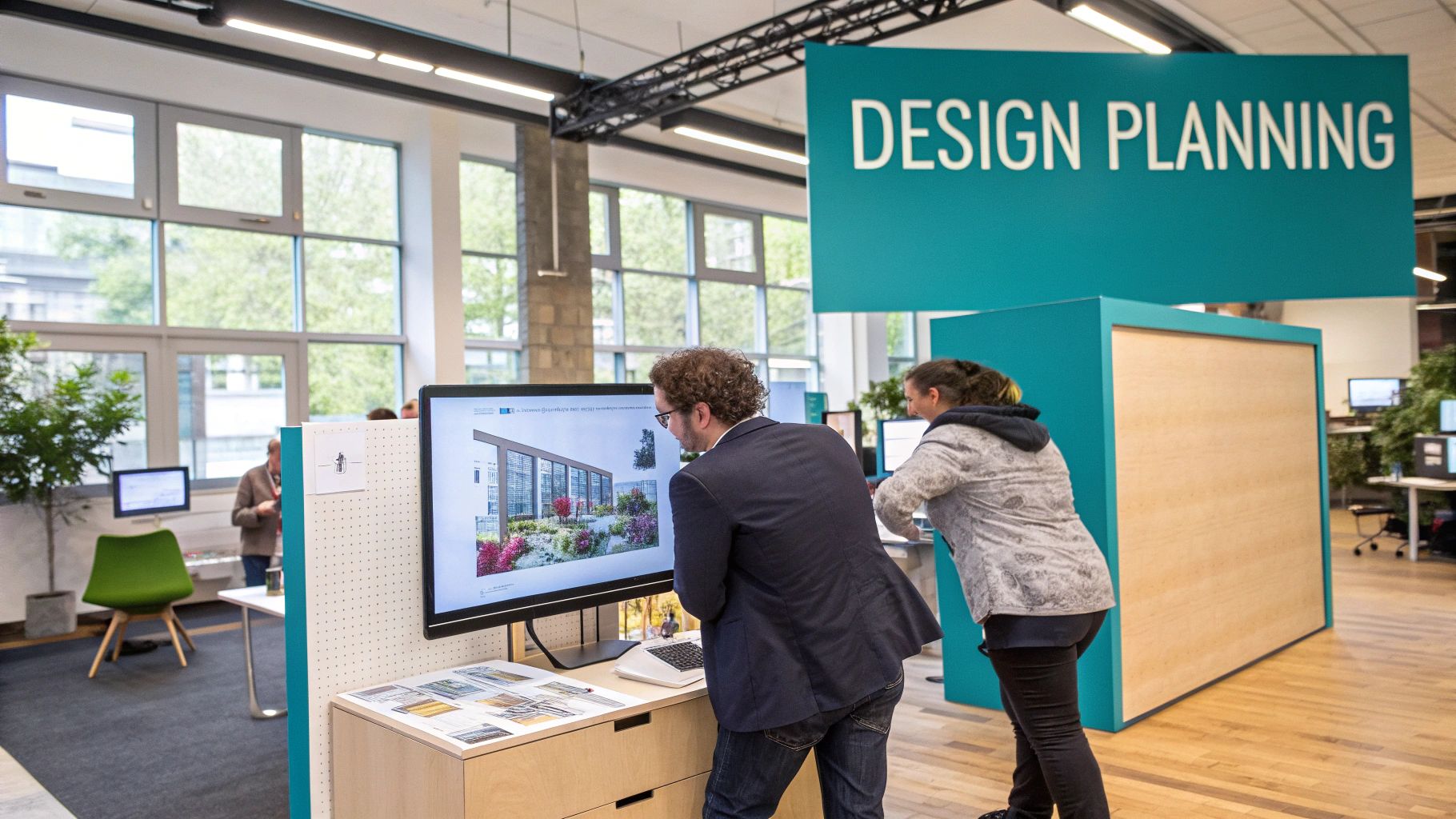
The goal of an exhibition stand build isn't just to fill your allotted space; it's to create a branded environment that actively works for you. A great build is a strategic tool, separating the stands people walk past from the ones they feel compelled to enter. To achieve this, every decision must be deliberate, starting with the fundamentals.
Laying the Strategic Foundation
Before a single sketch is drawn, your strategy must be crystal clear. This foundation ensures your booth is more than just walls and a logo—it's an engine for achieving your goals.
- Set Clear Goals: What does success look like for this show? Is it generating 50 high-quality leads, launching a new product with impact, or cementing your brand as an industry authority? Your primary objective will dictate every design decision that follows.
- Know Your Audience: The flow of the space, the messaging, and the technology should all be tailored to the specific people you want to attract. How can your booth solve their problems or answer their questions?
- Live Your Brand Identity: Your stand is your brand in 3D. It must feel authentic, reflecting your company's personality, values, and visual style at every touchpoint.
- Design for Functionality: The layout must support your team's on-site activities. Do they need a private meeting room, a stage for live demos, or an open, inviting area for casual conversations?
A well-executed exhibition stand doesn’t just occupy floor space; it creates an experience that resonates with visitors long after the event ends. Think of it as your brand's physical handshake with the entire industry.
Your Blueprint for Success: Planning and Concept Development
The success of your exhibition stand hinges on a solid game plan developed long before construction begins. This is where you translate abstract marketing goals into a tangible vision. Rushing this stage is the fastest way to build a stand that looks impressive but fails to deliver a return on investment.
Nailing Down Your Core Objectives
Vague goals lead to forgettable stands. Instead of "increasing brand awareness," aim for a specific target like "booking demos with 20 key prospects." This clarity sharpens every subsequent decision, from booth layout to graphic messaging.
Consider how your primary goal directly influences the physical design:
- Generating Leads? You’ll need an open, inviting layout that pulls people in. Design clear pathways to demo stations and include a semi-private area for serious conversations. The entire experience should make capturing contact information feel natural.
- Launching a Product? The new product is the hero. Your design must demand attention. Use dramatic lighting, interactive displays, or a central podium to make it the undeniable focal point.
- Building Your Brand? This is about creating an immersive experience that tells your brand story. The exhibition stand build might focus on unique architectural elements, premium finishes, and comfortable seating that encourages visitors to linger and connect with your team.
For a deeper look at how these goals translate into the structure itself, our guide comparing prefab vs. custom trade show booths is an excellent resource.
Turning Goals into a Powerful Concept
With clear objectives, you can develop a design concept—a visual story that instantly communicates your value proposition. It must answer the one question every attendee is asking: "Why should I stop here?"
A detailed design brief is your most critical tool for collaboration with your stand builder. It ensures everyone is on the same page and should include:
- Your Brand Guidelines: Logos, color palettes, fonts, and imagery.
- Key Messaging: The one or two core messages you must communicate.
- Functional Needs: Storage for personal items, specific tech requirements, and meeting spaces.
- Inspiration: A mood board with images of stands, architectural styles, or environments you admire.
Budgeting and Finding the Right Partner
A realistic budget is the anchor for your entire project. It must account for more than just the physical build. Factor in design fees, shipping, installation and dismantling labor (I&D), technology rentals, and venue services like electricity and internet.
The materials you choose during the design phase have a massive impact on your budget and logistics. This infographic breaks down some common options.
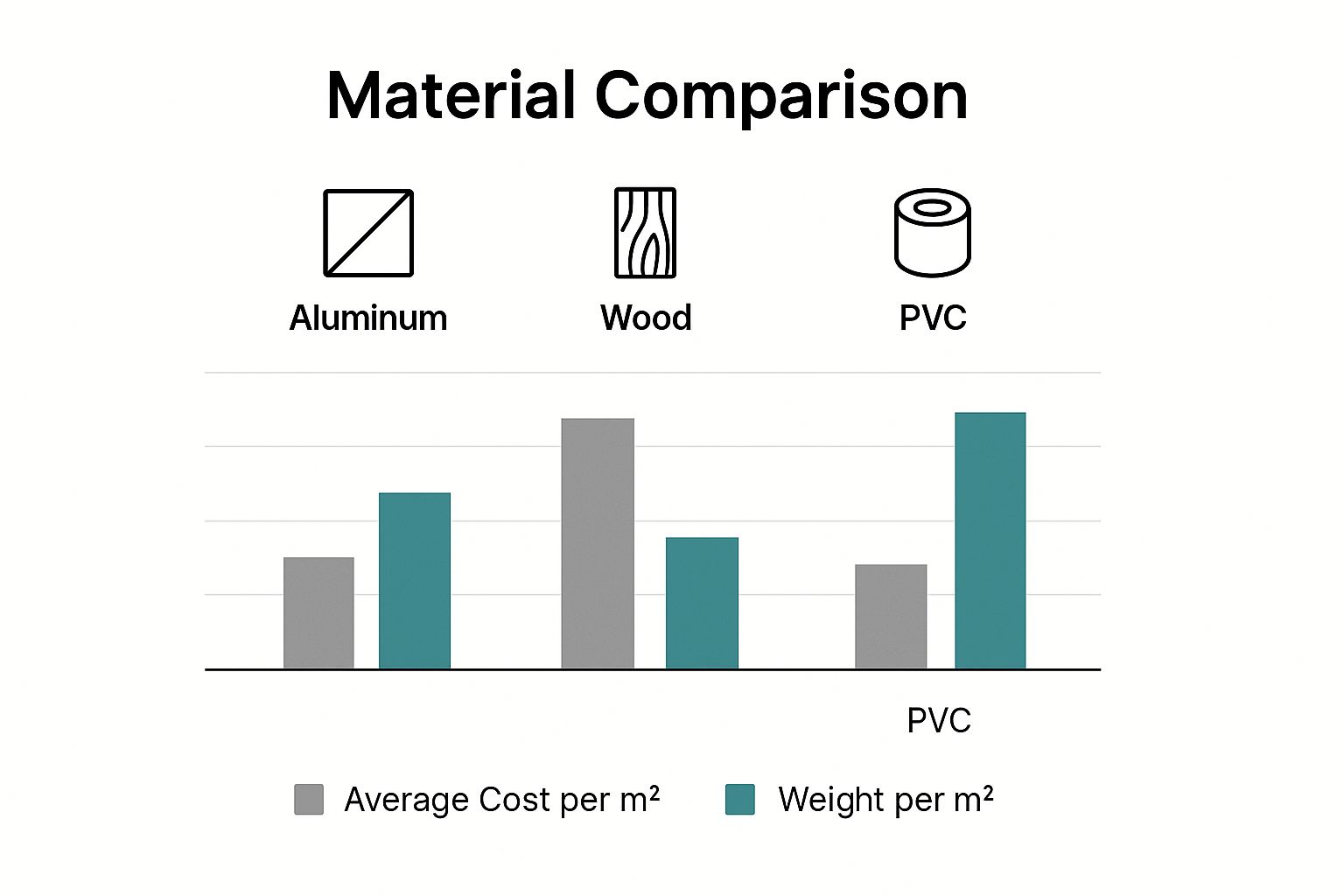
As you can see, a classic wooden build feels substantial and premium, but it's heavier and more expensive. An aluminum system, conversely, is lighter on both the scales and the budget. These are the kinds of trade-offs you'll navigate with your design partner.
The best stand builders act as strategic partners, not just vendors. They ask smart questions, offer creative solutions to budget constraints, and ensure the final build is a perfect marriage of form and function.
Choosing Your Build Materials and Method
The materials you select for your stand do more than define its appearance; they are the foundation of your budget, durability, and installation efficiency. This is where your creative vision meets the practical realities of weight, cost, and reusability. Making the right choice is critical, whether you’re planning for one major show or a full calendar of events.
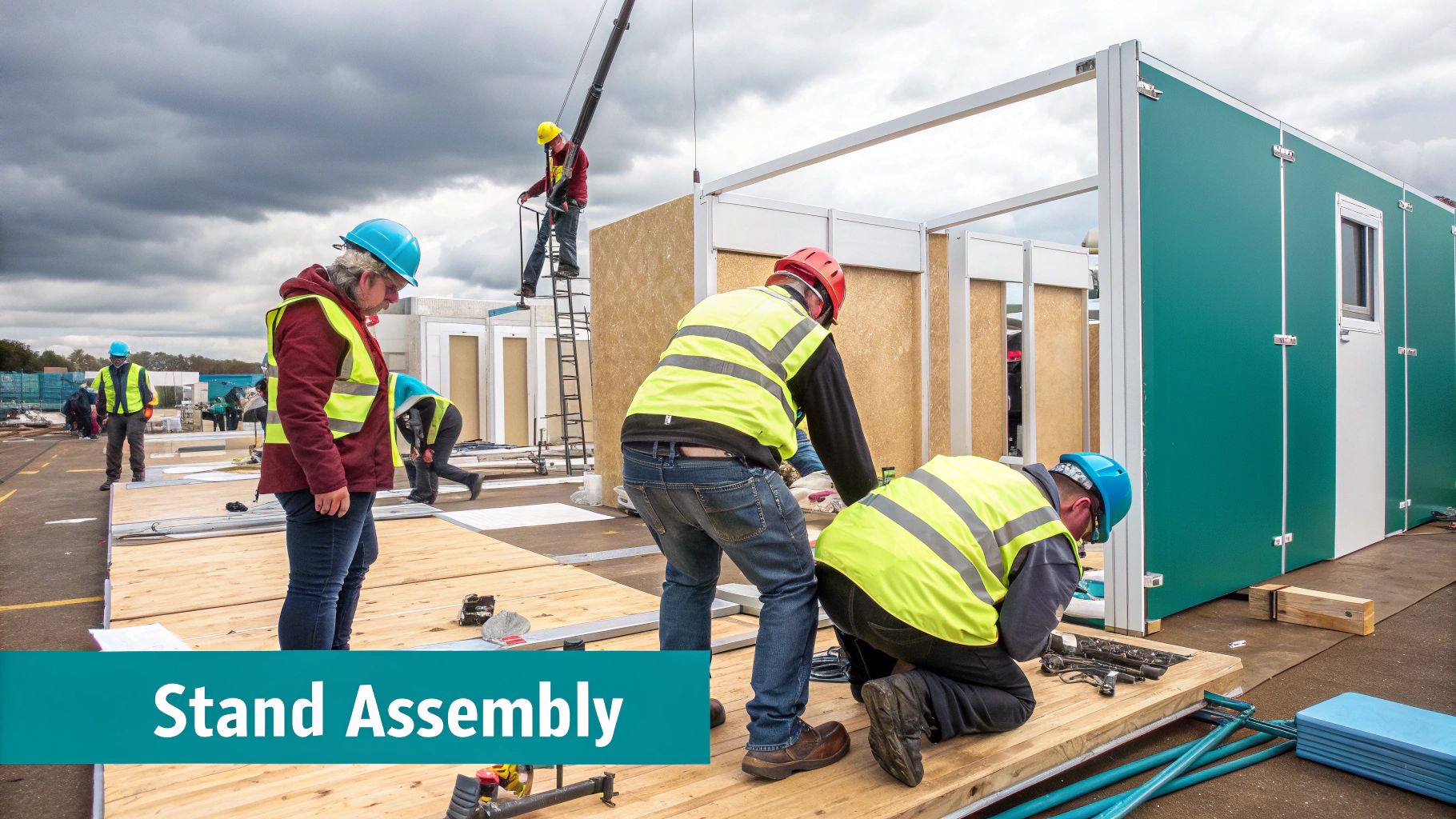
The Great Materials Debate
The raw materials of your booth set its entire tone. A heavy, custom-milled wood structure communicates permanence and quality, while a lightweight aluminum frame with fabric graphics feels agile and modern.
Here’s a look at common material choices:
- Wood (MDF, Plywood): Ideal for creating solid, architectural shapes and achieving a premium, custom-built feel. Wood is perfect for one-off builds where you need to make a unique statement, but its weight increases shipping and installation costs.
- Metal (Aluminum, Steel): Aluminum is the workhorse of the exhibition industry, forming the backbone of most modular systems. It offers a fantastic balance of strength and light weight, making it a cost-effective choice for multi-show exhibitors.
- Fabric Graphics: Tension fabric systems are ubiquitous for good reason. They deliver vibrant, seamless imagery, and their light weight can dramatically reduce shipping and drayage costs. The fabric vs. vinyl for trade show displays debate often comes down to the desired finish and durability.
- Plastics and Laminates: Perfect for finishing touches like countertops, reception desks, and flooring. These materials are durable, easy to clean, and available in a vast range of colors and textures.
A significant trend on the show floor is sustainability. Eco-friendly materials like recycled aluminum, bamboo, and low-VOC laminates are becoming more common as companies aim to reduce their environmental footprint.
Custom Build vs. Modular System
Your next major decision is the construction method. This choice between a fully custom build and a modular system will have a lasting impact on your budget, flexibility, and long-term event strategy.
A custom exhibition stand build is a one-of-a-kind structure created from scratch for a single event. This approach offers complete creative freedom to design a true architectural showpiece—perfect for a major product launch or flagship event. The trade-off is a higher initial investment and a structure that is not designed for reuse.
A modular system is built from a kit of standardized parts that can be reconfigured into different layouts. Think of it as a sophisticated construction set for exhibitors. Designed for reuse, modular systems offer fantastic value for a busy event calendar. While you may not get the unique architectural form of a custom build, today's systems can create stunning, premium-quality designs.
Making the Right Choice for Your Business
So, custom or modular? The answer depends entirely on your event marketing strategy.
A high-stakes, one-time event may justify the expense of a custom masterpiece. However, if you exhibit three or more times a year, the cost savings and flexibility of a modular system are almost impossible to ignore.
Consider these key factors:
- Frequency of Use: The more shows you attend, the stronger the financial case for a reusable modular system becomes.
- Budget: Custom builds have higher upfront costs for design, fabrication, and shipping. Modular systems have a lower initial cost and save money on logistics over time.
- Adaptability: If you book different booth sizes, a modular system is designed for that flexibility. A custom stand is a fixed asset.
- Brand Impact: While custom builds deliver a unique "wow" factor, don't underestimate modern modular stands. With high-end fabrics, creative lighting, and smart design, they can look and feel like a premium, custom space.
Mastering On-Site Logistics and Installation
You can have the most brilliant stand design in the world, but it’s worthless if it doesn't arrive on time and get assembled correctly. The final, high-stakes phase of on-site logistics and installation is where a successful exhibition stand build truly comes together. This is the moment your vision transforms from packed crates into an immersive brand environment.
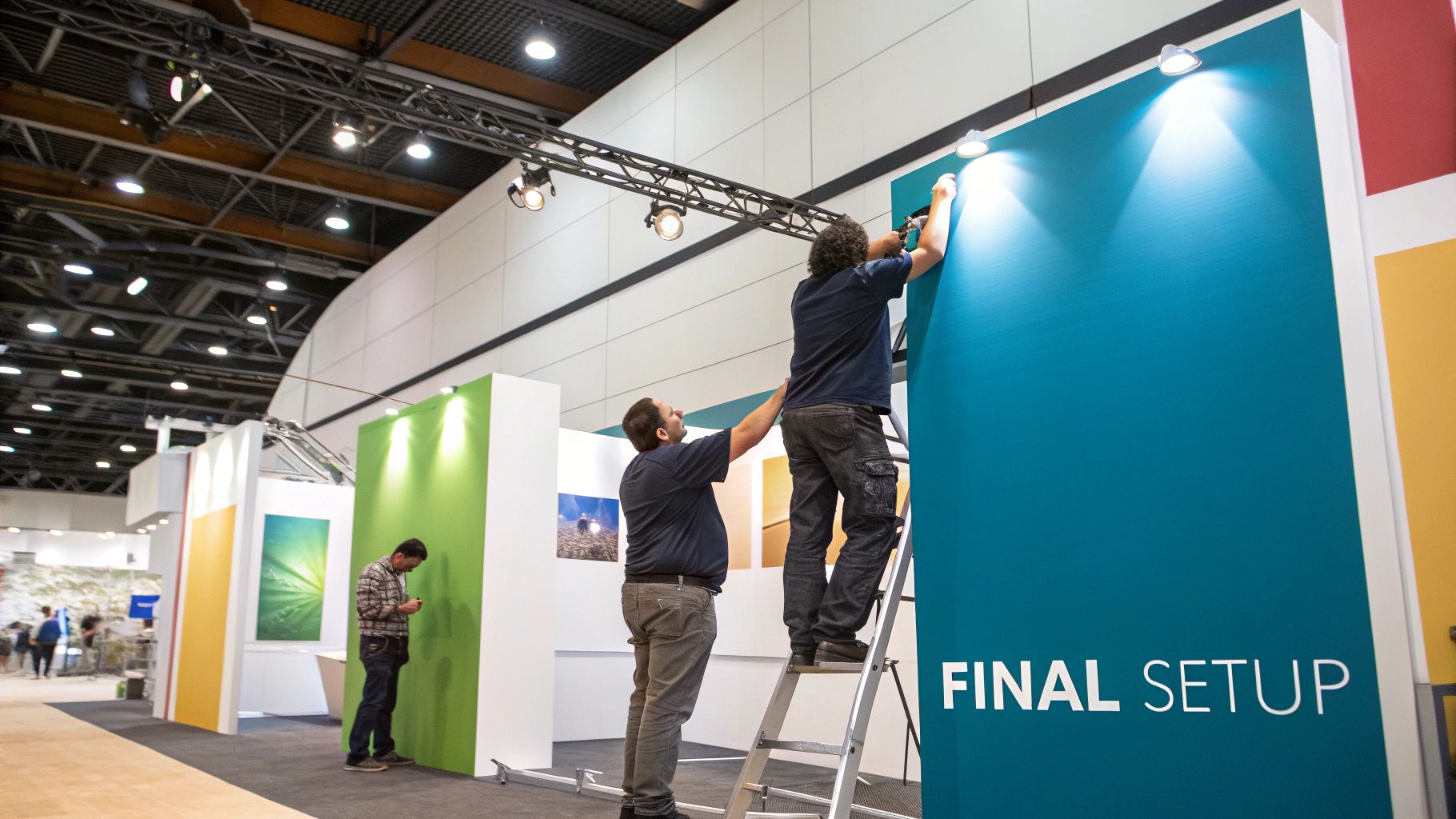
Navigating Shipping and Freight Management
Getting your stand from the workshop to the venue can be fraught with challenges, from transit damage to costly delays. Success begins with smart packing. Your build partner should use durable, custom-fitted crates designed to protect every component. Each crate must be meticulously labeled with the show name, company name, and booth number to ensure the drayage team can deliver it efficiently.
Mishandling is a significant risk, which is why investing in quality trade show shipping cases is a wise decision that protects your assets for years. Pay close attention to shipping deadlines, as missing them can result in steep late fees and delays.
The On-Site Installation and Dismantle Process
Once your freight arrives at your booth space, the Installation and Dismantle (I&D) team takes over. This specialized crew is responsible for assembling your stand and, after the show, taking it down. Key players include:
- Build Team: Experts who physically construct the stand—framework, walls, flooring, and counters.
- Electricians: Hired through the official show contractor to handle all power connections safely.
- Riggers: Certified professionals who manage any elements hanging from the ceiling, such as banners or lighting trusses.
A clear floor plan with detailed electrical and rigging layouts is the I&D team's bible, minimizing confusion and avoiding costly on-the-fly changes.
Time is money on the show floor. Union labor rates often double for overtime. A well-organized build plan that gets the team in and out efficiently is one of the most effective ways to control costs.
Preparing for Common On-Site Challenges
Even with meticulous planning, issues can arise. Being prepared to troubleshoot will keep your setup on schedule.
- Missing Components: Your I&D supervisor should perform a full inventory as soon as the crates arrive. If anything is missing, they can immediately coordinate with the build shop to expedite the part.
- Damaged Graphics or Panels: Shipping can be rough. It's wise to have a local print shop on standby for emergencies and to pack a small repair kit with touch-up paint.
- Electrical Issues: If a screen doesn’t turn on, check the power source first. If that fails, you'll need to call the show electrician back to diagnose the problem.
Successful on-site management comes down to proactive planning and clear communication. By understanding the logistics and planning for the unexpected, you ensure your exhibition stand comes together smoothly, setting the stage for a successful show.
Ready to build a booth that commands attention and delivers results? The expert team at Storm Displays is here to guide you through every step of the exhibition stand build process, from initial concept to flawless on-site execution.
Explore our full range of trade show solutions, including custom booths and versatile rentals, at https://stormdisplays.com and request your personalized quote today.
